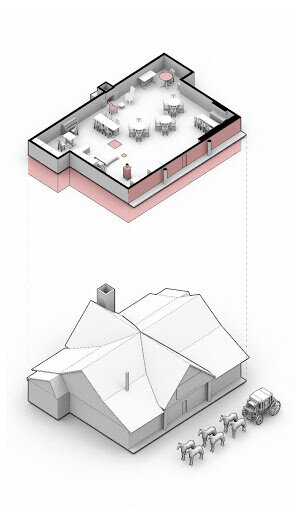
(Image: pinterest.com)
Architecture as Character: “The Hateful Eight” Becomes Nine
By Jake Monroe
Architecture and cinema have formed a relationship through film progression thought the 20th and 21st centuries. This relationship has its roots theater extending beyond the silver screen. Often this relationship acts to create setting, to ground the characters and give them an environment to react to and use to their advantage. It is often used strategically by the filmmakers as a tool for conveying what they set out to tell. At times, however, in the film the architecture transcends the role of place and becomes an active participant in the story at hand. It acts and reacts to alter and progress the story. The Hateful Eight, directed by Quentin Tarantino, is a beautiful example of this kind of architecture in film. I will discuss how the cabin in the film transcends set to become an active character and ultimately have a sense of self.

(Image: imdb.com)
After the first few chapters, the films exist almost exclusively within a one-room cabin called Mini’s Haberdashery. It is here that the original set of characters; Daisy Domergue, Sheriff Chris Mannix, John “The Hangman” Ruth and Major Marques Warren, first meet the characters already in the cabin; Joe Gage, Oswaldo Morbray, General Stanford Smithers, and Mexican Bob. The first set of characters is led to believe that everyone is there for the same reason. To find shelter from the storm.
At first glance the cabin acts traditionally as a set should. It grounds the characters and the situations at hand. Creating a microcosm for human interaction to be put on display, a fundamental quality to performance storytelling. Because the cabin acts as a canvas for the characters to interact upon we must begin to question the character of the cabin in these interactions. What effect is the cabin having on the interactions of the people within?
At the end of the film, in what is thought to be a one-room cabin, it is revealed that there is another room and another individual who has been just inches away from the rest of the characters the entire time. He is only hidden by a thin veil of floorboards. At this moment that architecture displays itself as something that must be further analyzed.
Roughly halfway through the film, the viewer is introduced to a narrator. This slight change in composition completely changes one’s relationship to the film. You are no longer situated inside the cabin on the same level as all the characters but now reminded that you are indeed an outside entity with no real bodily investment. It reminds the viewer that as an exterior onlooker you are not required to choose sides and participate but rather purely observe. It distances the viewer from the action in the film reminding them that this is a fabricated world that they are observing.
It is because of this distancing that we can start to question the nature of the cabin and its fundamental existence. Once we are reminded that this is a fictional world, a cabin can come to life and play a role different than any architecture with its foundation in reality. I believe that the narrator can be directly seen as the voice of the cabin. It can be seen as a character whose voice has only now been revealed at the midpoint of the film. At this moment, we must now begin to question the position of the cabin as a character the same as we have been questioning all other characters up to this point. Is it participatory or is it merely an observer? Has it taken a side, or does it exist without bias? Does it have motives and if so, what would they be?
These questions become particularly interesting when knowing that the narrator is voiced by the director Quentin Tarantino. I believe that we can start to see the cabin not only as a participant but as a director for the activities that begin to transpire through the film. Without the cabin the deeds done would not be the same.
Borders

I believe that the cabin can be seen as a director in multiple ways. First, the cabin actively acts to create borders both physical and symbolical. Just as the director of a film would direct certain shots to guide the viewer into seeing the composition and story that they propose, the cabin limits the viewer and its inhabitants to a single room. It uses its four walls to condense the frame of view and in many ways the country into merely a few hundred square feet.
As soon as racial tension begins between the people within the cabin, the interior begins to act as a boarder. The table is suggested to divide the cabin in half. One side as the union and the other the confederacy. In many ways, the cabin acts as an experiment. Condensing the entire nation at this moment in time down to a single room. It reveals the remaining tensions between a north and south dealing with the aftermath of the civil war and the remaining aggression attributed to it.
The walls further act as a border quite literally obstructing the characters and the viewer from all the events happening behind them. In this way the cabin is actively hiding information. Aiding in the plans of the Domergue Gang. We see this even further when the final member of the Gang is revealed to be hiding in the basement, a room the characters and the viewer did not realize existed until this time. It is important to mention that this event occurs much after we are introduced to the cabin as the narrator. While we have had the cabin speaking to us for much of the movie, why would it choose not to mention that there is another person hiding in a room it has also not displayed? This is when the nature of the cabin as an active participant in the film comes to fruition. If the cabin did not have a side in the plot it would be transparent not actively hiding information from the other characters and the viewer.
EMPATHY
Empathy can be seen as a fundamental way to distinguish humanity. Minnie’s Haberdashery in multiple ways creates empathy between itself, characters, and the viewer. By restricting the setting of the film it forces the viewer to fill in the gaps with their mind to build the world the film is set in. It invites the viewer to participate in the story in a way that very few films do, it asks you to be a part of the production.
In an essay about Dogville, which takes a similar approach to set design, Tarja Lanine states, “By removing the setting, von Trier renders his film transparent, after which the spectators develop sensitivity to their seeing that draws them further into the process of meaning-making, at the level of the lived body. The spectators view the film with their bodies to an ever-increasing extent, not because of the subject matter, but because of the way in which the subject matter comes to life.” Creating a lack of context, the set asks us to be creative and empathetic towards it in the story telling process and therefore displays an empathy towards us understanding that the viewer has the capacity to be creative and have empathy.
The lack of setting in the film is key to experiencing the film and getting into the “mind” of the characters involved. We begin to see the cabin of the nation itself, with characters from different political, racial, economic, gender, and labor backgrounds. By putting the viewer in such close quarters with the characters and an understanding that they are unable to leave with an unawareness of the world surrounding the cabin, the viewer must participate in the drama of the film. The film leaves ones with a need to pick sides and question all motives of the other characters and even the cabin itself just as the characters must do.
AN ARCHITECTURE WITH SELF
What gives architecture character outside a fictional setting and into our own? In his 1969 sound art, “I am Sitting in a Room” Alvin Lucier suggests a method for finding the character of a room. It starts with Lucier reciting a roughly thirty-second monologue and recording it within a room. He then plays the recording back into the room and records that. He does this process repeatedly until the only thing left is the reverberations from the sound he made with his voice. It strips away all meaning and significance to the sounds leaving only what is in a sense the room itself.
As the meaning of the sound is slowly stripped away and we no longer can connect the sounds to any significant signifiers we begin to hear the “voice” of the room. It can be seen as saying something to the room and going through a process to discover what the room says in response. The room’s response will be different with every new thing that is said to it. It will be different depending on what clothes one is wearing when they talk to it. The response will be different if one talks to a room from a different location within it. And the response would change in every room in existence. This could be construed as a kind of self-awareness and empathy towards another through sound.
To experience music, some philosophers would suggest, is a keyway to understand our humanness and self-consciousness. Douglas Hofstadter writes about these ideas in his book Gödel, Escher, Bach: an Eternal Golden Braid. He implies that in order to comprehend music we must have a self-conscious. Your self-consciousness is a constant repeating process of comparing a model of self that you have developed for yourself to models of self that you have developed for others. What allows us to comprehend music in a deeper way, is to in simple terms, “put ourselves in another’s shoes” to comprehend music as more than a string of tones but as a string of conscious human thought. You must have a self-conscious to envision yourself as somebody else,
The issue is that it is impossible to make an accurate model of the self for another person. In order to create these models of self, we must approximate based on our own model of self and our past experiences with another. It is this process of approximation that makes music so intriguing to listen to as humans. It reminds us of things we have done or would like to do. It makes us think about the experiences of others and the impact those experiences have made on them. It asks us to attempt to be in the mind of the creator and understand the theoretical complexities of sonic composition. In the end, music forces us to be empathetic. We must understand others in relation to ourselves for music to be perceived. Music is in this way a symptom of our collective consciousness.
We can see evidence of an empathy a building has towards sound, addressing it in a linguistic and musical way. Both of which we consider fundamental to our humanness and we see as evidence of our self-awareness. Although no, I do not believe this is enough evidence to claim the building is conscious by any means, However, it does give us a framework in which to understand the humanity of architecture through its generation of sound and reactions to the activity of humans around it.
CITATIONS
1- The Hateful Eight. The Weinstein Company, 2015.
2- Laine, Tarja. “Lars Von Trier, Dogville and the Hodological Space of Cinema.” Studies in European Cinema 3, no. 2 (2006): 135.
3- Alvin Lucier, “I am Sitting in a Room”, 1969,
4- Hofstadter, Douglas R., 1945-. Gödel, Escher, Bach : An Eternal Golden Braid. New York :Basic Books, 1979.

LOGO DESIGNED BY MEENTS ILLUSTRATED
from REVIEW BLOG - Every Movie Has a Lesson https://ift.tt/36kapNF







No comments:
Post a Comment